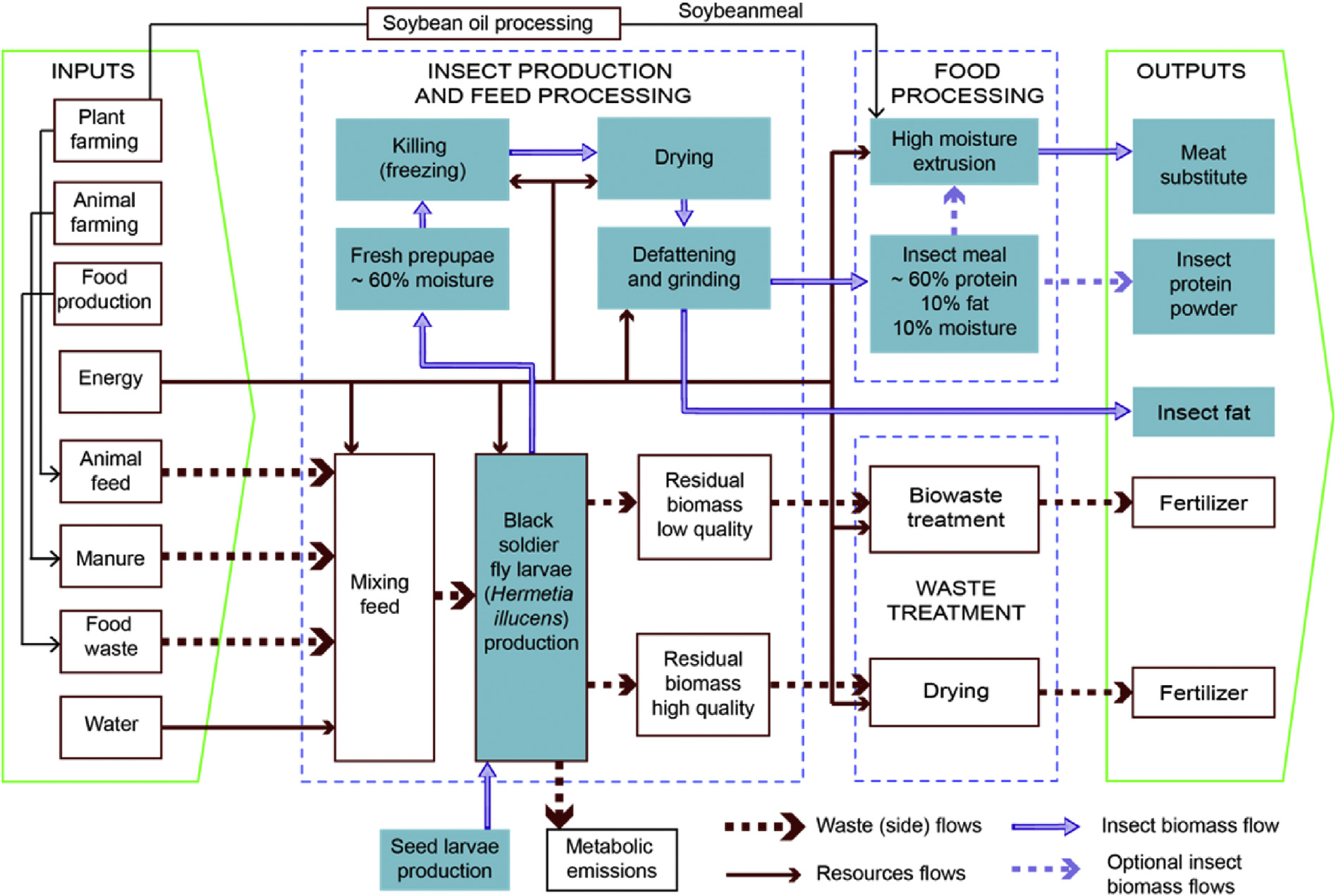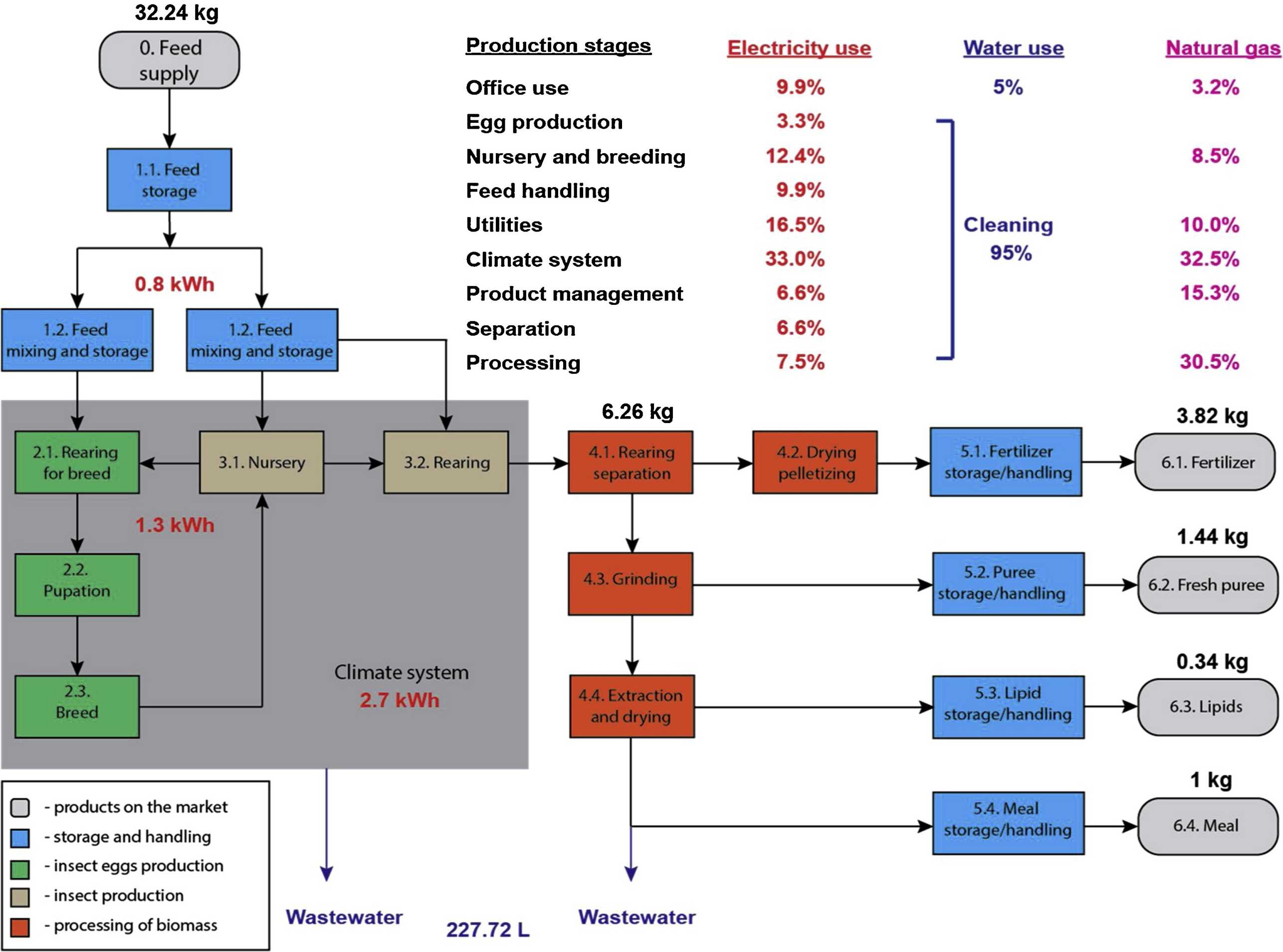Insect Sustainability and Processing
The emergence of insect production as a source of sustainable protein, aimed to substitute traditional feeds and foods, indicates the need to perform their environmental impact assessment with a holistic approach and on a fair functional basis. The study aims at life cycle assessment of insect production at industrial level and further insect biomass processing for feed and food purposes. In order to identify a relative sustainability state of insect-based products, the results of life cycle assessment are compared to the appropriate benchmarks (protein feeds, whey protein powder, and chicken meat). Current study includes an analysis based on industrial insect production data, with further scenarios modelling based on data from industries, databases and literature. It is indicated that environmental performance of insect based feed could be beneficial, provided that suitable diet is selected. Protein diets are responsible for high environmental impacts and high insect yields, while the utilization of manure is environmentally beneficial, but does not result in high yields. Low value food processing by-products (distilled grains) and high-impacting waste streams use for insect growing are confirmed to be among the best strategies for sustainable feed production. The production of insect-based protein powder and meat substitute, based on food by-products, is 2–5 times more environmentally beneficial than that of traditional products. The need for extended studies of different insect species use in combination with identified beneficial options is highlighted.
Selected publications
Smetana S., Schmitt, E. & Mathys A. (2019). Sustainable use of Hermetia illucens insect biomass for feed and food: attributional and consequential Life Cycle Assessment. Resources, Conservation & Recycling, 144, 285-296. external page DOI
Heuel, M., Sandrock, C., Leiber, F., Mathys, A., Gold, M., Zurbrügg, C., Gangnat, I., Kreuzer, M. & Terranova, M. (2021). Black Soldier Fly larvae meal and fat can completely replace soybean cake and oil in diets for laying hens. Poultry Science, external page DOI
Gold M., von Allmen, F., Zurbrugg,C., Zhang, J., Mathys A. (2020). Identification of Bacteria in Two Food Waste Black Soldier Fly Larvae Rearing Residues. Frontiers in Microbiology, 11:582867. external page DOI
Gold, M., Binggeli, M., Kurt, F., de Wouters, T., Reichlin, M., Zurbrügg, C., Mathys, A. & Kreuzer, M. (2020). Novel Experimental Methods for the Investigation of Hermetia illucens (Diptera: Stratiomyidae) Larvae. Journal of Insect Science, 20: 21. external page DOI
Gold M., Egger J., Scheidegger A., Zurbrugg C., Bruno D., Bonelli M., Tettamanti G., Casartelli M., Schmitt E., Kerkaert B., De Smet J., van Campenhout L., Mathys A. (2020). Estimating black soldier fly larvae biowaste conversion performance by simulation of midgut digestion. Waste Management, 112, 40-51. external page DOI
Gold M., Cassar, C.M., Zurbrugg,C., Kreuzer M., Boulos S., DienerS., Mathys A. (2020). Biowaste treatment with black soldier fly larvae: increasing performance through the formulation of biowastes based on protein and carbohydrates. Waste Management: 102, 319–329. external page DOI
Gold M., Tomberlin J.K., Diener S., Zurbrügg C. and Mathys A. (2018.) Decomposition of biowaste macronutrients, microbes, and chemicals in black soldier fly larval treatment: A review. Waste Management, 82, 302-318. external page DOI
Aarts K.W.P., Jansen, M.P.M. Jacobs,A.L.M., Mescher M.C., Prenter R., Mathys A. & De Moraes C.M. (2018). Processing of insect larvae. EU patent application. Application No 18175914.3-110
Smetana S., Palanisamy M., Mathys A., & Heinz V. (2016). Sustainability of insect use for feed and food: Life Cycle Assessment perspective. Journal of Cleaner Production, 137, 741-751. external page DOI
Smetana S., Mathys A., Knoch A. & Heinz V. (2015). Meat Alternatives: Life cycle assessment of most known meat substitutes. International Journal of Life Cycle Assessment, 20(9), 1254-1267. external page DOI

